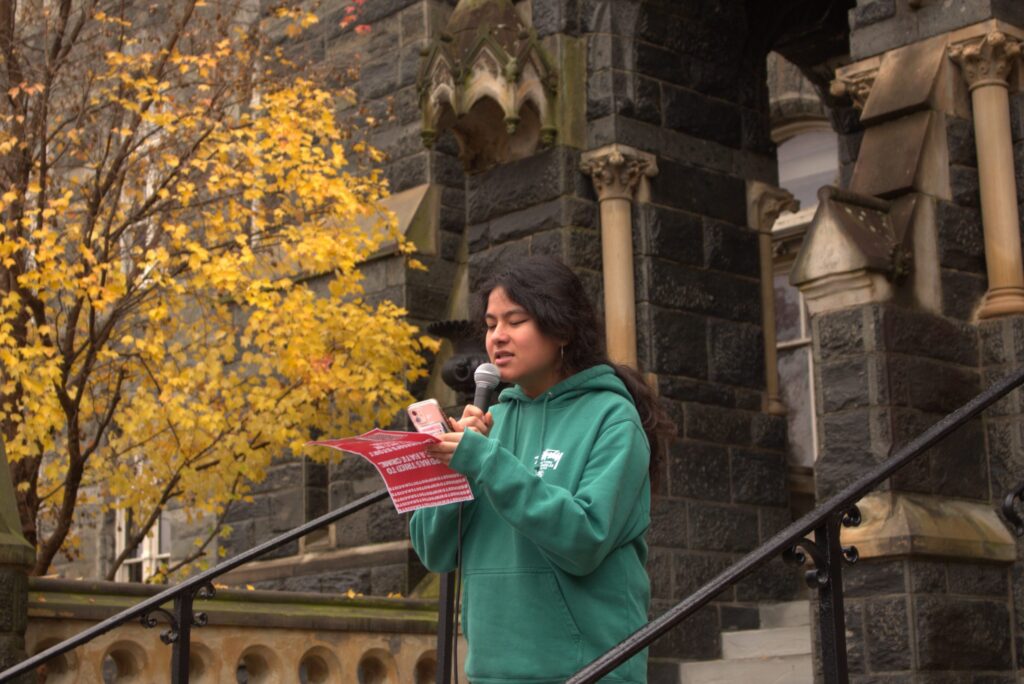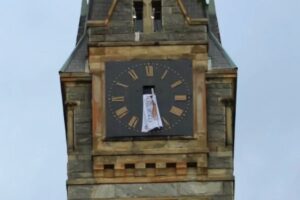Editor’s note: This article discusses anti-Black hate speech, sexual assault, and systemic violence. It follows a Dec. 6 article detailing the initial stages of the GU Protects Racists sit-in.
After the fourth consecutive day of the GU Protects Racists (GUPR) sit-in, Georgetown University administrators responded to the demands of LaHannah Giles (COL ’23) and other student organizers with a campuswide Dec. 8 email. Despite initially expressing anger and disappointment with the university’s response, organizers decided to end the sit-in after a final meeting with administrators on Dec. 9.
“The sit-ins are ending because the sit-ins were successful in that the university has committed with built-in timelines and accountability measures for meeting each one of the demands laid out by LaHannah. And they have committed to continued conversations with organizers of the sit-ins,” Sanchi Rohira (SFS ’24), one student organizer, said.
Students have been sitting in front of the President’s Office since Dec. 5, from 9 a.m. to 5 p.m. Organizers decided on the morning of Dec. 9 following a final meeting with administration to end the sit-in, believing that doing so would not end the progress they had made toward justice for Giles.
The occupation of Healy Hall began on Dec. 5 to demand university action in response to a hate crime Giles experienced last Georgetown Day. What followed was a well-attended multi-day sit-in and a Dec. 7 march for justice across campus, one of the first times hundreds of students have organized sustained protest against university policy since the 2020 Black Survivors’ Coalition (BSC) sit-in and GU272+ protests.
Among GUPR’s initial demands included the expulsion of the perpetrator, an apology for the harm caused by the university’s refusal to acknowledge the hate crime occurred, an internal and external review of the university’s handling of the case, and an explanation of how GUPD’s relevant video footage was lost, among others. The university’s Dec. 8 email attempted to respond to these demands as a result of conversations between student organizers and administration over the course of this past week.
“Last night there was a lot of anger, after a long day of sit-ins, the email came out late, and then we see parts of it that don’t reflect our conversations. There was anger last night,” Olivia Henry (COL ’24), another sit-in organizer, said on Dec. 9. “This morning, after a night of full rest, after acknowledging how much that email truly was, we were all collectively of the mind: We have made so much progress.”
Organizers have been consistently meeting with administrators since Dec. 1. It was not until Dec. 7, however, that the university provided its first official written response to Giles’ demands during their meeting. Following negotiations and a widely attended student protest across campus, a revised version of this written response was sent out in a university-wide email on Dec. 8. To the disappointment of Giles and other organizers, the university’s email had been missing key tangible commitments, including a failure to ensure increased funding for the Students of Color Alliance (SOCA) and to provide a concrete timeline for other commitments made.
“For me, this email and document means nothing to me until they’ve taken the actions they’ve committed to,” Giles said on Dec. 8.
However, the willingness of administrators on Dec. 9 to change some of the language in the email, commit to increasing SOCA’s funding, and commit to meeting with organizers in January to provide updates on the other demands discussed allowed organizers to feel comfortable ending the sit-ins. Organizers also noted that they followed the precedent set by the BSC sit-ins, which also ended following a university email despite not all demands being immediately implemented.
“In our meeting with admin this morning, they were completely amenable to making all the changes we brought up: language shifts, timelines. Because of that we’re ultimately like, awesome, now it’s time for the institutional work,” Henry said. “And because of that shift from protesting to institutional advocacy, we made the decision to stop the sit-ins.”
Several of the commitments outlined in the Dec. 8 email included punitive repercussions for the perpetrator. Should a specific individual be held accountable, according to the university email, the perpetrator would likely face suspension or dismissal per the Office of Student Conduct’s (OSC) Sanctioning Guidelines. The university’s six-month delay to produce a campuswide public response frustrated Giles.

Photo by Nora Scully Giles and student protestors chanted in Red Square during the march.Photo by Nora Scully
“I’m not happy that it took this long to get a response from the university. This should have happened six months ago,” Giles said on Dec. 8. “I will say that I feel a little hopeful that this is one step forward, but I’m not happy about it.”
The university also apologized in the email for its insufficient communications about the April 29 hate crime. Officials had emailed New South residents on April 30 without notifying Giles, and had included a mention of the incident in the Campus Climate Survey email on May 2. Neither, however, accurately classified what Giles experienced as a hate crime.
“We acknowledge the pain this has caused students and members of our community and the seriousness of the concerns that have been expressed, and we apologize,” Rosemary Kilkenny, the vice president for Institutional Diversity and Equity; Jeanne Lord, the interim vice president for Student Affairs and Dean of Students; and Jay Gruber, the chief of police, wrote in the campuswide email.
On a structural level, Giles’ other demands included extending the BSC Treatment Initiative, a group of providers and services focused on addressing the impacts of racial trauma with particular emphasis on serving women and femmes of color who have experienced sexual assault, violence, or harassment. The demands also pushed for adding a communal space for the Black Student’s Alliance beyond solely the Black House, and increasing funding for SOCA.
The university agreed to both extend the BSC providers for up to the next five years and increase funding for SOCA, although they did not provide a specific amount. In terms of finding a communal meeting space, administrators committed to “exploring the best possible solutions for a communal space beyond normal business hours on short notice,” as well as providing updates for this demand in January.
“Until there is tangible action for many of the things they’ve committed to, [only] then I will feel fully satisfied,” Giles said on Dec. 8.
The university’s Dec. 8 response was the product of several earlier conversations with the administration. These meetings have included Kilkenny, Lord, vice president and chief of staff Joe Ferrara, associate vice president for Public Affairs and Business Policy Cal Watson, and others. According to student organizers, president John DeGioia, who had not been present at the meetings, the university’s Board of Directors, and the Black Alumni Council have all been informed of the ongoing situation.
According to Mariela Vasquez (COL ’25), who has participated in the negotiations and helped organize the sit-in, administrators initially deflected blame for the handling of Giles’ case. “My initial reaction was that the university was very concerned with issues of liability and defending their name and their reputation,” she said. “I feel like not all responses were sufficient, and that at times they were making comments sort of like, ‘Oh well, I wasn’t in the room when this decision was made,’ or, ‘It wasn’t on me, it was on other people.’”
Vasquez added that the absence of Gruber from these meetings complicated communications between student organizers and GUPD, whose questions for the police department had to go through administrators.
In the campuswide email, the university also apologized for the loss of the GUPD footage and their failure to convey the circumstances under which the footage was lost; they again reiterated that the footage was lost as a result of a server failure. This was only discovered when the OSC contacted GUPD for additional access to the footage during their investigation. Despite this official statement, Giles told students after the meeting on Dec. 8, the administration blamed the loss on “internal confusion,” which Kilkenny confirmed in a brief comment in passing to the students present at the sit-in.
Furthermore, the university committed to enhancing the system for reporting possible bias-related incidents and filing complaints with IDEAA through both internal and external reviews. More specifically, an internal review of the April 29 hate crime investigation with the OSC, GUPD, and IDEAA will be conducted, along with an external review of Georgetown’s handling of “hate crimes and bias-related incidents,” which will begin in the spring 2023 semester.
The university noted that it has changed the classification of Giles’ case from the initial label of “bias-related incident” to “hate crime.” This change was documented and added to the Daily Crime Log on Dec. 6, two days after the start of the sit-in, due to “a careful reconsideration of the information that has been provided.”
According to several organizers present at a meeting with administrators the morning of Dec. 8, Ferrara acknowledged the demands have been reconsidered by administrators as a direct result of student activism.
Only two days before this response and the end of the sit-in, a multiracial group of nearly 300 students gathered to march across campus in protest of the university’s lack of accountability. Student organizers have attributed the overwhelming support they received from the student body as essential to the university’s willingness to implement some change or to meet with them at all.
On Dec. 7, students convened in front of Healy Hall to march to GUPD’s office and the IDEAA office—the two primary institutions involved in the mishandling of the hate crime investigation. The justice rally programming included a land acknowledgment, a poem shared by Angelene Leija (COL ’23), singing the Black National Anthem, extensive chanting, and six minutes of silence to acknowledge the six months Giles’ demands for justice remained unmet.

Photo by Nora Scully Leija performed her poem in front of hundreds of students at the rally on Dec. 7.Photo by Nora Scully
“I think today went beautifully. I got very emotional just seeing the people that showed up,” Leija said. The poem she wrote compared the interconnected nature of institutional failures and personal loss.
As students marched between GUPD and the steps in front of Darnall Hall, they chanted, “How the fuck did they lose the footage?” and “This is what community looks like.”
While turnout was significant, several students stressed that a commitment to anti-racism activism is not fulfilled by attending one rally. “This isn’t the only time that you should be doing something that is actively anti-racist, you should continue to read and build community with these people,” Deborah Wey (SFS ’24) said.
Students have drawn parallels between this sit-in and the BSC occupation of the President’s Office three years prior—both protested the continued cycles of violence and police misconduct against students of color, and both movements relied chiefly on the uncompensated labor of Black student activists, especially Black women and non-binary people.
“It’s kind of like a weird full circle. We’re back here again after the university has failed to do their job of protecting students. We’re kind of back at the same crossroads of GUPD just not doing their job,” Saleema Ibrahim (SFS ’23), a student organizer who was at the BSC sit-in, said.
Ibrahim added that BSC helped shape a feeling of community during her freshman year, and sees the BSC treatment plan, which includes access to therapists, as a good thing. But she expressed frustration that the demands of the BSC weren’t fully implemented. “Will it ever actually fully come to an end? Will it ever actually lead to any change?” she questioned, referring to institutional failures and exhaustive student advocacy.
Reflecting on Wednesday’s rally, Ase Frazier (MSB ’23) expressed that while the turnout was encouraging, the consistent demand for student advocacy and activism over the years is indicative of a larger problem at the university. “It’s not just about individuals who experience hate crimes, it’s the fact that they continue to happen and nothing happens for those individuals and nothing happens for our community,” they said. “Anytime something happens to one of us, it happens to all of us. This is a fight for all of us at Georgetown.”
Although the sit-in has concluded, organizers stressed that the fight for justice is not done: “[Administrators] are well aware that if they fail to live up to any of the demands or at any point block the student body out of the process, protest will resume,” Rohira said.
“Justice is incomplete, but LaHannah is hopeful with the progress being made,” GUPR wrote in an official statement on Dec. 9.
As for next steps, Giles said the movement is adapting.
“Our protest is taking a new form,” Giles said on Dec. 9 following the end of the sit-in. “We recognize that the organizers needed rest, and the students needed rest as well. We were doing all of this during finals season and it’s taken a toll on us but we got a majority of the demands met in the end.”
One demand has yet to be answered: accountability for the student responsible. According to Giles, the university will notify organizers on Dec. 16 whether or not the perpetrator will face consequences. “This will also determine our course of action as a group,” she said. “I am hoping with everything in me that this student is expelled and that we do not need to plan another action against the university.”
To express unity against institutional racism and an increase in racially-motivated acts of hate on campus, a solidarity rally will be held on Healy Lawn at noon on Saturday, Dec. 10. The rally calls for all students to stand in solidarity to achieve justice for Giles and “dignity for all minorities and communities of color on campus,” according to GUPR’s Instagram. It is currently sponsored by GUPR, South Asian Society, Muslim Student Association, Hindu Students Association, and Black Leadership Forum, and will continue to advocate for justice for Giles.
“I have been so moved, grateful, and blessed to be part of a movement that these students regardless of their background, regardless of the fact that it’s finals season, showed up day in and day out, sat on the floor, and wrote their papers while simultaneously holding the university’s feet to the fire in demanding justice for LaHannah,” Rohira said.
This article was updated at 8:01 p.m. on Dec. 9 to include a comment from Giles regarding the end of the sit-in.





Comments 0
Comments are closed here.